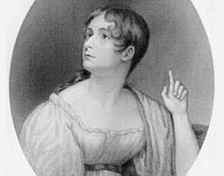This review references two additional websites:
Letters of a Victorian Lady
Francis Barnard
http://www.barnardf.demon.co.uk/
Victorian Women Writers Project
Indiana University
http://www.indiana.edu/~letrs/vwwp/
These three sites—Victorian Women Letters Project, Letters of a Victorian Lady, and the Victorian Women Writers Project—all concern women writers of the 19th century.
The Victorian Women Letters Project aims to make available the correspondence of early- to mid-Victorian British women writers. The first phase of the project concerns the correspondence of Anna Brownell Murphy Jameson (1794-1860) and Harriet Martineau (1802-1876). More than 1,000 records have been generated from the correspondence of these two women. The site gives a 1,500-word introduction to each author, including details of her life, and her social circle and her connections; these introductions provide an important background to using the correspondence. The letters are accessed by the search function. It is possible to search each author’s letters separately or the two collections together by terms such as “writer,” “addressee,” “date,” “people mentioned,” or a combination of these fields.
Jameson and Martineau were important figures in contemporary debates on literature and social issues such as abolition and the “woman question.” Their correspondence may be fruitfully used by students to trace the networks of association connected with these questions in 19th-century Britain and Europe. Full transcription of the letters are not yet available, so the site remains most useful as a record of the connections maintained through correspondence, rather than allowing detailed analysis of the correspondence itself.
The Victorian Women Writers Project comprises 300 texts by roughly 60 Victorian women writers in Britain. The site includes anthologies, novels, political pamphlets, religious tracts, children’s books, and volumes of poetry and verse drama. A key advantage of the site lies in the texts’ encoding in Standard General Markup Language (SGML). This allows for keyword searches on the entire collection. The site also includes a valuable links page that provides access to more than 75 internet resources and 20 journals.
Letters of a Victorian Lady is a much smaller site on a less well-known Victorian woman. It consists of almost 50 letters by Ada E. Leslie (born ca. 1860), who traveled in Europe and Asia in the 1880s and 1890s. The letters were written to Ada Leslie’s cousin, Pollie Galsworthy, during her travels as a governess and while attached to members of the European aristocracy in the capacity of governess and lady-in-waiting.
The site is the initiative of Francis Barnard, owner of the letters and descendant of Pollie Galsworthy. A key disadvantage lies in the relative lack of contextualization of the letters. While the author’s genealogical research gives as much detail as possible on the life of Ada E. Leslie, this is still relatively thin. This is an engaging site, yet it comes across as the work of a passionate family historian rather than a scholar. The biographical details, for example, are arranged haphazardly. Some appear on the introductory page, while others are scattered between photographs the author has taken while retracing the steps of his ancestress. The letters are arranged in five sections according to date and geographical location. There is no search function.
Students might examine the letters for themes such as the author’s highly self-conscious sense of herself as an Englishwoman abroad, both in her opinions of local manners and customs and in her position as traveler and respectable woman. “One sees many things that are, to English eyes, painfully repulsive,” she writes of Greece in 1890, “the beggars are a bother and when anyone like myself absolutely refuses to give them anything, then I am afraid they say very wicked things, but in a case like mine ‘Ignorance is bliss’ for I don’t understand their jargon.” Such comments are suggestive of the complexities of female identity in the late 19th century. Women writers had both to observe their surroundings and keep their eyes and ears closed to that which a respectable woman should not see or hear.



